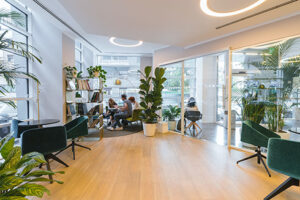There has been a faster and greater evolution of the workplace and the biggest shift in working patterns over the past couple of years. For many businesses, this has challenged the conventional approach to work, leaving business leaders and workers alike to grapple with introducing new concepts and policies to factor in different routines. One concept that has become commonplace is hybrid working; according to a CIPD survey, 40% of employers expect more than half their employees to work from home for at least a portion of the week, even after the pandemic. Whilst this gives a high degree of flexibility, it is often getting confused with flexible working – both of which will have an impact on your current and future office space requirements. In this blog, DeVono highlights how each can impact the size, location and type of workplace needed.

What is hybrid working?
Hybrid working refers to a blend of working across multiple locations with the office remaining central and complemented by remote working from home, a coworking space or an alternative such as a coffee shop. Hybrid working allows employees more autonomy to plan their working week. Hybrid working is not a new concept, but it has gained greater acceptance following successive pandemic lockdowns.
What is flexible working?
Flexible working relates to an employer accommodating the different needs of its workforce to an individual’s working arrangement. Flexible working can cover a whole host of options, from staggered work times, flexitime or part-time working, compressed working weeks or even job sharing. This can also sit alongside hybrid working to achieve greater flexibility for both employee and employer. The optionality of such working styles has been contractual, for many organisations it remains as such, whilst the pandemic clouded the granting of such arrangements, it is expected that clearer boundaries and policies will be put in place.
1. Who needs a desk? – the impact of remote working
What has become one of the main conundrums from a space planning perspective is identifying who you need to provide space for and when. Not so simple as the pandemic has meant that most people have adopted a variety of working patterns and locations. To get a clearer understanding of your space needs, businesses must set a certain level of expectation and/or policy in terms of frequency of attendance in the office. This will provide a benchmark on which to base assumptions. It is at this stage that you factor in those who are on flexible working contracts and their patterns.
Giving everyone their own desk regardless of their work pattern for most businesses is not cost-effective or needed. Understanding more than just work patterns will add a further level to your calculations. What type of work is done when people come into the office, what are people in the office for? This will inform not just desk space requirements but also wider workplace design.

2. Does the office design need to change?
How businesses use space will change due to adopting either hybrid working patterns or having a greater number of employees working flexibly. Several workspace elements should be considered, whether it is more space devoted to team collaboration, an increased number of meeting rooms to help facilitate in-house and remote calls, or more on-site amenities such as break-out areas, phone booths and private offices, to name just a few. Whilst a reduction in desks/space could be achieved with fewer people in the office at any one-time, additional requirements could negate any changes and may even lead to an increase in space needed.
At DeVono, we offer a range of real estate solutions, from finding your ideal office space to formulating your workplace strategy alongside our design and build team Dthree Studio. Our designers and workplace consultants identify your space needs and subsequently design to support a shift in working styles, office use and the wider role of the workplace within an organisation. Whether the workforce has returned to business as usual or a greater degree of remote working takes place, worker expectations have shifted over the past two years, and office design and provision is one tool that can be deployed to attract and retain talent and to improve productivity. Any design change must result in the creation of a fundamentally better and more productive space, not just to shoe-horn in a new way of working.
3. Invest in technology
The work-from-home directive ushered in a sea change in the world of work, and the return-to-the-office has resulted in increased remote working. Remote working exists in employees’ homes, the office, or any third spaces used. As businesses steam towards a future incarnation of the office and begin to embed short-term and long-term working strategies, the experience for users has to be seamless, whether they log in from home, the coffee shop, or the office.
Harness the power of technology for your workforce. Often it is not only about purchasing new solutions, but better utilising the ones that are already available. Some firms may have access to many tech platforms, many of which can contribute towards a more effective workplace technology strategy. Leveraging the data you already have will allow the business to make informed decisions backed by data, not just assumptions. It will also ensure that your next workplace decision-making process will be the right one.
Our Workplace Consultancy and Insights teams have produced a paper highlighting how technology can support a hybrid workplace, partnering with proptech consultancy Trustek.

4. Which office solution should I choose?
Most businesses do not have the luxury of being able to start a new office search to support a shift in working patterns. Therefore, getting to grips with the challenges and opportunities of your existing space at the earliest stage possible will significantly help towards embedding any new work policy.
For those in search of a new space, ensuring that you have established the parameters set out in the previous three points, you should start to get a better idea of your space needs. In addition to the list of requirements, office searches are significantly influenced by cost, which will ultimately heavily influence the type of workplace solution and subsequent fit-out and for how long.
The range of workplace solutions for businesses is now better than ever, with more options within each offering too. The choices include;
- Conventional leasehold
- Remainder leases such as subleases and assignments
- Managed offices
- Serviced offices
- Coworking
Each of these options have their benefits to help support a business achieve greater flexibility in working patterns and workforce agility. Whether you are looking for space on a longer term, interim space to adjust and trial new ways of working or remain flexible throughout – there is something for everyone.
Ultimately, although hybrid and flexible working are different concepts, similarities remain in the shape of increased autonomy in working practices. Technology has enabled us to work in any environment. Whether considering or implementing hybrid or flexible working, the workplace must be reimagined to cater to modern work practices and the varying individual employee needs.
Every occupier, irrespective of scale, is trying to work out what the current situation means for them and their workforce, what has worked well over the past couple of years, what is reversible or irreversible, what is worth keeping and even extending. And, fundamentally, what will be their own version of “new normal” going forward, that is specific and appropriate to their own operation, people, customers, and culture.

With the physical workplace heavily scrutinised over the past few years, all of the other factors that drive contribution have become more visible: the capability of enabling technologies; the quality of leadership, management and communication; the clarity and robustness of key business processes, collaboration and dependencies; the recognition of each individual’s willing contribution without presenteeism; their wellness, drive and commitment when allowed to balance their personal and working worlds; and an employer’s understanding and acknowledgement of each employee as a person, their specific personal circumstances, their flexibility. The workplace provision needs to suit accordingly, and that is where DeVono can support you and your team on your real estate journey and help inform your workplace strategy.
For assistance with your commercial real estate strategy, please get in touch with us on +44 (0)20 7096 9911 or contact us via info@devono.com.



